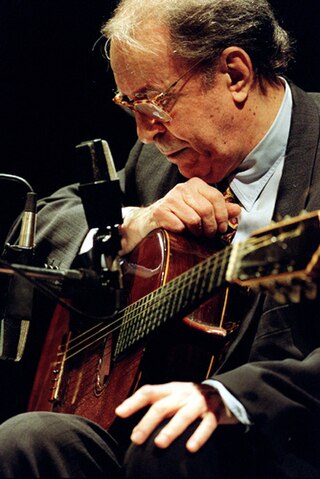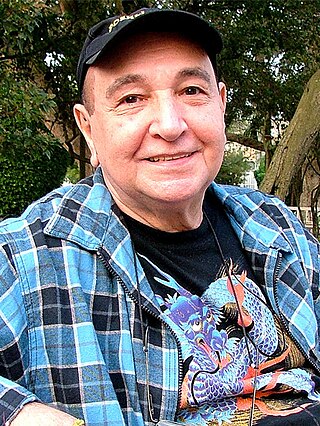
João Gilberto was a Brazilian guitarist, singer, and composer who was a pioneer of the musical genre of bossa nova in the late 1950s. Around the world, he was often called the "father of bossa nova"; in his native Brazil, he was referred to as "O Mito" . In 1965, the album Getz/Gilberto was the first jazz record to win the Grammy Award for Album of the Year. It also won Best Jazz Instrumental Album – Individual or Group and Best Engineered Album, Non-Classical. Nominated at the Grammy 1978 in the category Best Jazz Vocal Performance, album Amoroso, and winner category in Grammy 2001 with João voz e violão Best World Music Album.

"Garota de Ipanema", "The Girl from Ipanema", is a Brazilian bossa nova and jazz song. It was a worldwide hit in the mid-1960s and won a Grammy for Record of the Year in 1965. It was written in 1962, with music by Antônio Carlos Jobim and Portuguese lyrics by Vinícius de Moraes. English lyrics were written later by Norman Gimbel.

Eumir Deodato de Almeida is a Brazilian pianist, composer, arranger and record producer, primarily in jazz but who has been known for his eclectic melding of genres, such as pop, rock, disco, rhythm and blues, classical, Latin and bossa nova.

Getz/Gilberto is an album by American saxophonist Stan Getz and Brazilian guitarist João Gilberto, featuring pianist and composer Antônio Carlos Jobim, who also composed many of the tracks. It was released in March 1964 by Verve Records. The album features the vocals of Astrud Gilberto on two tracks, "Garota de Ipanema" and "Corcovado". The artwork was done by artist Olga Albizu. Getz/Gilberto is a jazz and bossa nova album and includes tracks such as "Desafinado", "Corcovado", and "Garota de Ipanema". The last received a Grammy Award for Record of the Year and started Astrud Gilberto's career. "Doralice" and "Para Machucar Meu Coração" strengthened Gilberto's and Jobim's respect for the tradition of pre-bossa nova samba.

Jazz Samba is a bossa nova album by Stan Getz and Charlie Byrd released by Verve Records in 1962. Jazz Samba signaled the beginning of the bossa nova craze in America. Stan Getz was the featured soloist and the tracks were arranged by Charlie Byrd, who had first heard bossa nova during a tour of Brazil in 1961.

Dom Um Romão was a Brazilian jazz drummer and percussionist. Noted for his expressive stylings with the fusion band Weather Report, Romão also recorded with varied notable artists such as Cannonball Adderley, Paul Simon, Antonio Carlos Jobim, Jorge Ben, Sergio Mendes and Brasil '66, and Tony Bennett. He was the percussionist Tom Jobim brought to the studio for the album Jobim recorded with Frank Sinatra in 1967 for Reprise Records, Francis Albert Sinatra & Antônio Carlos Jobim.

Getz/Gilberto #2 is a live album by Stan Getz and João Gilberto, released in 1966. It was recorded at a live concert at Carnegie Hall in October 1964. The previous album Getz/Gilberto won the 1965 Grammy Awards for Best Album of the Year and Best Jazz Instrumental Album - Individual or Group, among others. The painting on the cover is by Olga Albizu.

The Composer of Desafinado, Plays is the first album by Antônio Carlos Jobim. Released in 1963, the album features a dozen instrumentals arranged by Claus Ogerman, whose work would mark the beginning of a lifelong musical relationship with Jobim. Of these twelve songs, nearly all of them are jazz standards. The opening track "The Girl from Ipanema" is believed to be the second most recorded song in history behind The Beatles' "Yesterday," and a recording of the song by Astrud Gilberto and Stan Getz became a worldwide hit in 1964.

Wave is the fifth studio album by Brazilian jazz musician Antônio Carlos Jobim, released in 1967 on A&M Records. Recorded in the US with mostly American musicians, it peaked at number 114 on the Billboard 200 chart, as well as number 5 on the Jazz Albums chart.

Claus Ogerman was a German arranger, conductor, and composer best known for his work with Billie Holiday, Antonio Carlos Jobim, Frank Sinatra, Bill Evans, Michael Brecker, and Diana Krall.
"Corcovado" is a bossa nova song and jazz standard written by Antônio Carlos Jobim in 1960. English lyrics were later written by Gene Lees. The Portuguese title refers to the Corcovado mountain in Rio de Janeiro.
"Meditation" is a bossa nova and jazz standard song composed by Antônio Carlos Jobim and Newton Mendonça. The English version has lyrics by Norman Gimbel. In Finland, the song was recorded in 1963 by Olavi Virta with lyrics by Sauki under the title "Hymy, flower and love". Erkki Liikanen recorded the song in 1967 with lyrics by Aarno Raninen under the title "Taas on hiljaisuus".

I Put a Spell on You is a studio album by American jazz singer, songwriter, and pianist Nina Simone. Recorded in 1964 and 1965 in New York City, it was released by Philips Records in 1965. It peaked at number 99 on the Billboard 200 chart and number 18 on the UK Albums Chart. The title track "I Put a Spell on You" peaked at number 23 on the Hot Rhythm & Blues Singles chart and number 28 on the UK Singles Chart.

The Shadow of Your Smile is a studio album by Astrud Gilberto. With arrangements by Don Sebesky, Claus Ogerman, and João Donato, it was released via Verve Records in 1965. It peaked at number 66 on the Billboard 200 chart.

João Donato de Oliveira Neto was a Brazilian jazz and bossa nova pianist as well as a trombonist from Rio Branco. He first worked with Altamiro Carrilho and went on to perform with Antonio Carlos Jobim and Astrud Gilberto. Because of the area he grew up in Brasil he was able to hear Cuban music on the radio. This influence would manifest itself in many of his compositions, piano, and trombone playing. Donato's most well-known compositions include: "Amazonas", "Lugar Comum", "Simples Carinho", "Até Quem Sabe" and "Nasci Para Bailar".
"Samba de uma Nota Só", known in English as "One Note Samba", is a bossa nova and jazz standard song composed by Antônio Carlos Jobim with Portuguese lyrics by Newton Mendonça. The English lyrics were written by Jon Hendricks. It was first recorded by João Gilberto in 1960 for his album O Amor, o Sorriso e a Flor.

Astrud Gilberto was a Brazilian samba and bossa nova singer and songwriter. She gained international attention in the mid-1960s following her recording of the song "The Girl from Ipanema".

Getz Au Go Go is a live album by American saxophonist Stan Getz and his quartet, featuring bossa nova singer Astrud Gilberto. It was recorded during two concerts in 1964 and released on Verve the same year as V6-8600.
"Vivo Sonhando" is a bossa nova song from 1962 with words and music by Antônio Carlos Jobim. English lyrics were added later by Gene Lees.
"Fotografia" is a bossa nova song written and composed in 1959 by Antônio Carlos Jobim. English lyrics were published in 1965 by Ray Gilbert.















